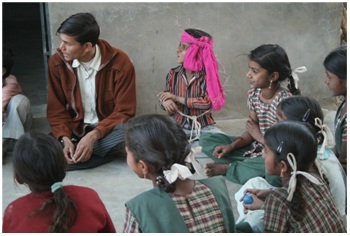Contribute
| Local Givings: Prashant Fadia Foundation And American India Foundation: DE Program Allows Glency Sheeba To Dream |
09/14/2011
“One day I’d like to see the Taj Mahal.†For Glency Sheeba,
age 14, a trip to see Shah Jahan’s masterpiece, carefully crafted for the love
of his life, would be a dream come true. Yet, just a few months ago, Glency had
no idea why millions of people every year travel to Agra to visit one of the
Seven Wonders of the World. However, the introduction of an American India Foundation
(AIF) program at her school has given Glency access to information about the
Taj Mahal and much, much more. Glency, a Class 9 student from PK Government Girls Higher
Secondary School in the Ambattur township of Thiruvallur, Chennai, always fell
slightly behind her peers in the classroom. “Glency always struggled a little
bit in the classroom, and no matter how much attention I gave her, it was hard
to engage her. For example, when I taught a lesson on the Seven Wonders of the
World, she couldn’t even remember most of them,†her Class 6-8 teacher, Ms.
Lakshmi, recollects. In just the few months since AIF’s Digital Equalizer (DE) program,
which provides computer labs and Project Based Learning (PBL) methodology at
schools that have little to no technological infrastructure, began at Glency’s
school she has become a shining example of how the DE program can have marked
improvement on children’s education. “The first project I completed was on the Seven Wonders of
the World, where I learned all about the Taj Mahal and the pyramids in Egypt
and the history of how they were built. After that project I decided to do one
on pollution because everywhere I go all I see is rubbish and I wanted to do
something about it. What I learned most is that we need to control our use of
plastics, and we need to have dustbins. We don’t even have any in our schools,â€
Glency laments. Glency’s teacher is amazed by the transformation her student
has undergone over the past few years. “Glency has become so engaged in the
whole PBL process that she is now a completely different student. She takes an
interest and now goes far above the standards we have set for our students! I
think she probably learns best through a visual and an investigative style
which is why the computer sessions have really helped her.†Glency reiterates this sentiment. “The textbooks and
classroom time is less interesting to me and harder to understand, all you do
is read. But in the computer classroom and with the DE projects, I get variety.
We get to see big, colorful pictures, maps, videos and even play games
sometimes.†Glency has not only been able to shine as a bright student,
but has taken what she has learned into her home. “From researching about
pollution I have changed my behavior, and now I put my trash in the dust bin.
Even my mother does the same now after I kept bugging her about it,†she
explains. Glency now uses computers in a multitude of ways, including
keeping an online journal about her life. “I make presentations about my life,
my family, and about the things I do or how I feel. Before I started using
computers in school I thought the computer was only for games, but there are so
many more things that you can do and learn about the world from it.†The DE program and new pedagogy has allowed Glency to
explore her creativity to help support her own learning. “Coming to the
computer lab is my favorite part about school; my knowledge is growing every
day. And with this knowledge I know I’ll be able to get a job as a teacher, and
make my family proud,†says Glency. Hopefully one day, she’ll be able to fulfill her teaching
goals, and perhaps even get to finally see India’s wonder of the world.
You may also access this article through our web-site http://www.lokvani.com/
